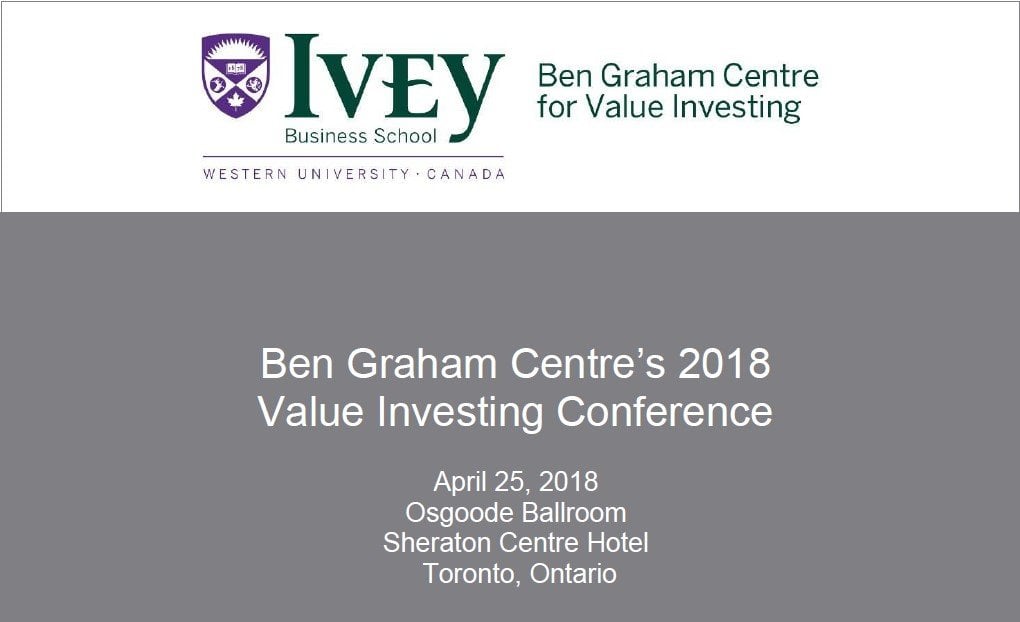Mason Hawkins speech from the 2018 Ivey Ben Graham Value Investing Conference in Canada from April 2018.
Also check out our Sohn Conference notes right here.
Also Baupost 2017 letter
Klarman On
the danger of Chinese leverage
Discipline while value investing in bubby times
Q1 hedge fund letters, conference, scoops etc
Well thank you (inaudible), it’s such a great honor to be invited to speak here with so many (inaudible) Canadian (inaudible) investors.
A philosophy teacher asked his student to sum up Socrates life in four lines, and here’s what he said. Socrates lived a long time ago. He was very intelligent. Socrates gave long speeches. His friends poisoned him.
Winston Churchill once cautioned an audience saying, quote, I’m going to give a long speech because I haven’t had time to prepare a short one.
For your sake I’ve had time to prepare a reasonably short one, yet it will include (inaudible) many of you have encountered.
03:00 (inaudible)
03:30
Co-ownership eliminates conflicting interests and best achieves the common objectives. The concept of investing in partnerships with our clients is one of our investment advantages and is important for us. Between our two private foundations, our retirement plan and (inaudible) capital, we are (inaudible).
Long term. Being a long term investor has distinct advantages. It reduces the number of decisions one must make. I allows you to focus on high probability investment outcomes. It minimizes friction or transactional costs. And it defers or eliminates tax liabilities, leaving that capital to compound for years.
Additionally being a long term investor puts you in a tiny minority of market participants, so there’s less competition, where you can concentrate on companies that will deliver much more free cash flow in three years while others are trying to guess the (inaudible). Over our 44 years Bob (inaudible) at Southeastern, we’ve held our investments for an average of 5 years.
Concentrated. Since Southeastern was founded in 1975, our portfolio has gone from 10-20 investments, depending on diversification mandates. And, we’ve always believed that (inaudible) investment (inaudible) had to be materially and demonstrably superior to our least qualified holding in order to supplant it.
Adding a marginal name to a defined unit portfolio of holdings pushes you into the world of quote “de-worse-ification”. We practice Warren Buffet’s admonition, “don’t put too many eggs in your basket, and pick them carefully”. And, agree with his declaration that, quote: “diversification is protection against ignorance, but if you don’t feel ignorant, the need for it goes down”.
John Maynard Keynes, who had a spectacular investment record managing several insurance company portfolios and the Kings College Foundation, addressed concentrated investing like this: “To suppose that safety first consists in having a small gamble in a large number of different directions, as compared to a substantial stake in a company where’s one’s information is adequate, strikes me as a travesty of investment policy.” End quote.
But to be a successful, concentrated, risk averse investor, you must: think independently, do your own appraisals, exercise incredible patience and discipline, be willing to hold cash, and then be courageous enough to go all in when you find a true investment qualifier.
Most often it’s when all (inaudible) and you must be unafraid to look stupid and (inaudible).
I’ll address some important investment qualifications in order.
Engaged. We believe it’s incredibly important to be engaged with our companies’ management. Not only to support them in this (inaudible) but to help them make intelligent capital allocation decisions. The wise deployment of a company’s cash is a paramount necessity to achieving an acceptable profit for a long term investor.
A bond analogy, highlights the magnitude of the re-investment function. In Sidney Homer and Martin Leibowitz’s “Inside the Yield Book”, the authors dissect the three components of a bond yield maturing. The accretion of the discount, or the amortization of the premium to par at maturity. The Coupon. And the Interest on the interest.
By way of example and to keep it simple. Assume that you buy a 10 year, 8% high yield debenture, issued at par, and hold it to maturity. Many would believe you earn an 8% yield at maturity. But as Homer and Leibowitz explained, that’s not the case. In order to earn an 8% yield at maturity, each of the interest coupons must be reinvested at 8%. If you put all the interest payments under your mattress, your compound return drops to 6.1%. If the coupon is reinvested at 12%, your compound return, well the yield at maturity rises to 9.5%.
So with the same bond, two investors can reap very disparate returns. 6.1% vs 9.5% in this example, or a 55% differential in results. The ultimate yield at maturity therefore depends on the re-investor and the profitability he or she, and how profitable he or she (inaudible) the coupons.
There are three identical components that determine a stock compound return. The accretion of the discount or the amortization of the premium to intrinsic value. The company‘s free cash flow coupons. And the interest on the interest, or the return an investor receives from the free cash flow as it is reinvested.
Continue reading here.













